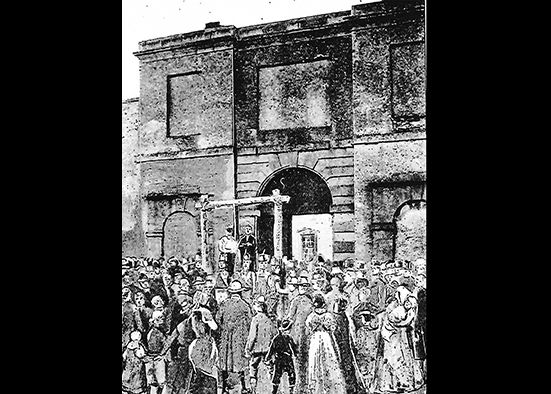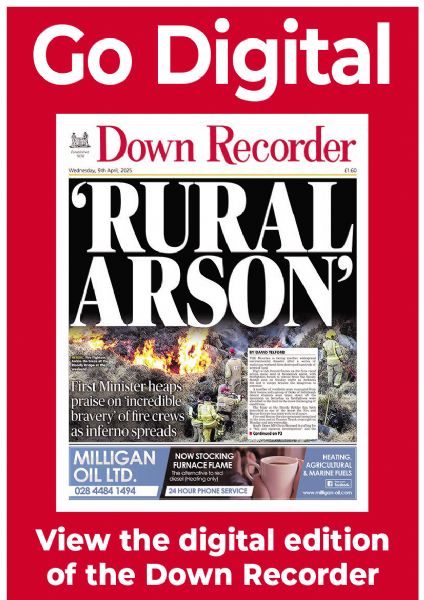Man executed by hanging at Downpatrick gaol for ‘most inhuman and bloody murder’
Man executed by hanging at Downpatrick gaol for ‘most inhuman and bloody murder’
17 January 2024

TWO hundred and one years ago, almost to the day, John Downey would seal his own fate by his actions in a gravel pit in the townland of Ardigon, near Killyleagh.
According to newspaper reports of an inquest, John Downey had been working with Thomas Charters in the pit on the morning of January 14, 1823.
Isabella Stevenson and her daughter, Jane, were later to give evidence stating they had seen Thomas at the gravel pit at approximately 8am and 10am.
Isabella told the court that she saw Thomas lying in the gravel pit about 12 noon with John Downey kneeling on him and thumping him on the head with stones. It was reported that whilst giving her evidence to the court, she fainted and had to be carried out.
James McCann, who also knew Thomas, witnessed him lying on his left side in the gravel pit with a large wound on the left side of his head and covered in blood.
James Stevenson, the father of Isabella, also observed this horrific attack and witnessed Downey the stone and pick up a spade. James stated that he left the scene and “called murder”. He later observed that the spade was covered with blood and when he returned to the scene Downey was about 30 yards away from the pit.
Jane Stevenson stated that she saw him run off.
Gawn Scott, who had known Downey since childhood, met him running away from the pit, covered in blood and being chased by a crowd.
Gawn stated that he later found Downey in the room of a house, coming out from under the bed “after having been stripped and washed”.
It appears that Downey was then arrested by a man called Harpur. Downey was brought before the magistrate, Thomas Potter, and charged with the murder of Thomas Charters. The magistrate later informed the court that he asked the prisoner what he had committed the murder with, to which he replied “a spade”.
Doctor Joseph Little carried out an examination of Thomas Charters and confirmed that the injuries inflicted on him appeared to have been made by a spade and a sharp stone.
The Rev Henry Cooke, minister at Killyleagh Presbyterian Church, had been at the scene after the body had been removed. He stated that after he “had performed his clerical duties and endeavoured to procure medical aid”. He examined the wounds on the deceased.
He later examined the gravel pit and located a stone covered with blood and hair. He kept this in his own custody under lock and key until the court case on Friday, March 28, 1823, at DownpatrickAssizes.
At the trial several other witnesses were called, and the defence were interested to know if they had any knowledge of any issues between the deceased and the defendant.
John Law, William Berry, Samuel Woods and James Ringland were all questioned.
Samuel Woods stated he had heard Downey say that he had “wrought with a pick at his father’s house to throw it down”, but there was no indication given that Thomas Charters had borne a spite in relation to this.
James Ringland said Thomas had told him that Downey had once knocked him down and “only for John Charters he would have killed him”.
The jury returned a guilty verdict and it was reported that the judge addressed John Downey as follows:
“John Downey, you have been found guilty, on the clear evidence of a most barbarous, bloody and inhuman murder. The unfortunate man, who was labouring in the same employment with you, and who was afterwards inhumanly murdered by you, from some diabolical spirit of revenge, which does not appear in evidence to have previously you any cause of offence.
“It appears that those ideas, which might have arisen from some supposed observations hostile to you, and supposed to have been uttered by deceased, whom you have murdered, that, of all your acquaintances, not one has supported such an assertion.
“They have abandoned you, and not one of them could utter a single syllable in your favour; but, on the contrary, the evidence of Ringland shows you had nourished a spirit of deadly hatred and revenge towards him for a considerable time. What a horrible picture must the recollection of that scene of foul atrocity present to your mind…..”
The judge invited John Downey to seek repentance for his crime and concluded: “It now only remains for me to perform the most disagreeable and afflicting part of my duty, namely, the pronouncing the sentence of the law, which is, that you be taken from whence you now are to the place from whence you came, and that, on Monday next, you are to be taken to the place of execution, your irons struck off, and you are then to be hanged by the neck until you are dead, and your body afterwards given to the surgeon of the county infirmary for dissection, and the Lord have mercy on your soul.”
On Monday, March 31, 1823, John Downey was executed in front of Downpatrick gaol. It was reported that he had “made ample confession of his crime” but he had stated that Thomas Charters “had started on him”.
According to press reports he was said to have forgiven his prosecutor, and whilst on the scaffold “begged the prayers of the vast multitude assembled to witness his execution”.
The reporters on the day believed that there was not much sympathy for him amongst the spectators.
The condemned man was attended by three Roman Catholic clergymen, although it was reported that he had persisted in saying up until two days before his execution that he was a Presbyterian.
“After a short interval spent apparently in devotion, at two o’clock the fatal drop fell, and launched this victim of ungovernable passion into eternity.”
The body was later removed to the County Infirmary for dissection. It is likely that this would be carried out under the auspices of James Hartwell who was the surgeon for the infirmary at that time.


